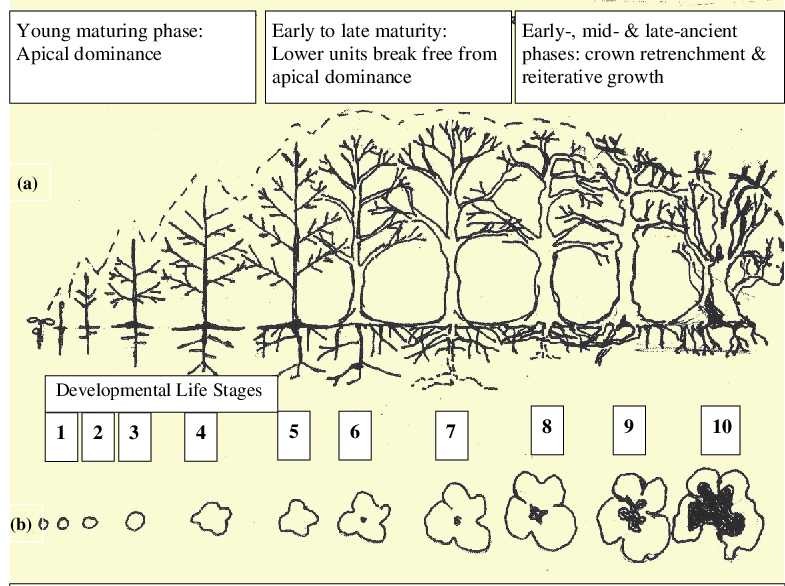We saw previously that larger trees planted in an environment with space for their roots and infiltration options can have 2-5 more benefits in terms of shade and heat reduction than larger trees planted in paved environments with little space for their roots. But there are other factors than environment to consider when categorizing trees in how many ecosystem services they can provide.
The first factor is the life phase a tree is in. Obviously older usually means larger and therefore more leaves and roots, and thus more capable to generate shade, create a habitat for other species, capture and retain water, filtrate air particles etc. A basic life phase overview starts from seedling to young tree, then an adult tree, and finally an old tree that might partially decay. When these phases change will depend on the species of tree, a second factor to consider. At some point the sap in a tree will not travel further up and the growth and structure of the tree will change. An oak tree could reach 1000 years of age, whereas birch trees struggle to reach 100. Getting an oak tree to become a yound adult would take around 300 years, meaning we have to rethink timelines of when we want which benefits to exist.

An adult tree is referred to as a category 1 tree. In a webinar from Stadswerk Marcel Steegh from SoilManias quantified the difference in benefits from a category 1 tree of 50-100 years old as 3000 times that of a young planted tree, which is a dramatic difference. It is definitely worthwhile to have a category 1 tree. One way to grade this is according to the norm NEN 2767, which rates trees higher in their adult phases and lower at their life start and end phases, with a total of 6 categories.
Each species will have a different age for their life phase, and this also comes with different sizes, another factor to consider when planning for certain benefits. Here you can find an overview of how tall each species can become under optimal conditions. Alder trees for instance become 10-35m tall, whereas the large leaved linden can become 30-40 m tall, which will impact most directly where shadows will be.
To help protect older trees we have a list of monument trees with over 15,000 entries of trees that are over 100 years old and have a special local significance. To judge how old a tree might be and if it already fits the criteria for being an adult tree, you can use this guide to estimate the age by measuring the circumference of the tree at 1.30m height, even on slopes. By combining this with the species, you can estimate the crown height and thereby derive what benefits we might experience from each individual tree.
It is crucial to protect the older trees we have, and equally important to keep planting new trees while simultaneously ensuring they have the right circumstances to grow to maturity and provide more of the benefits we need to survive our changing climate. That would be the final factor to consider, to make sure any new species we select will withstand as much as possible the changes we expect the coming decades, if not longer, given the lifetime expectancy of the species.




No comments:
Post a Comment